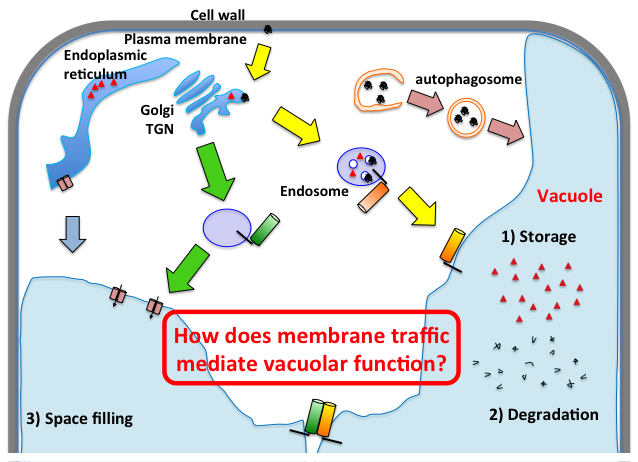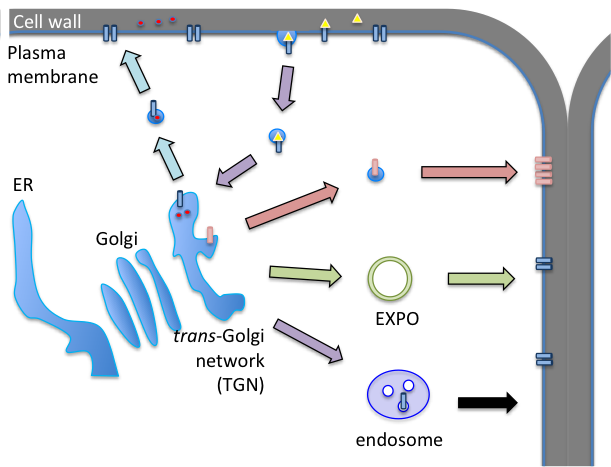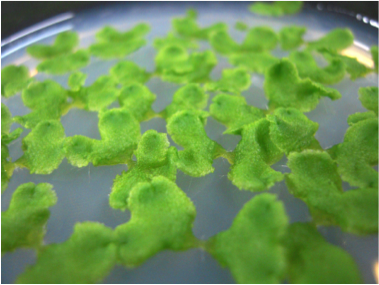What we are interested in:
- Basic mechanisms of membrane trafficking in plants
- Diversification and evolution of membrane traffic
- Organelle functions unique to plants
Current projects
Mechanisms and regulation of vacuolar transport
The vacuole is a terminal of the biosynthetic trafficking pathways from the ER, and the endocytic and autophagic pathways also merge with the vacuolar transport pathway. Plant vacuoles fulfill pivotal functions including not only degradation of waste contents in the cells, but also storage of various compounds, space filling, and the regulation of turgor pressure. To fulfill the plant-specific functions of the vacuole, the vacuolar trafficking pathway should have been tailored in a unique way during evolution. Morphology of the vacuole is also known to vary responding to intra- and extracellular conditions. For example, vacuoles in stomata, which are responsible for gas exchange in a major part of land plants, undergo drastic morphological changes during stomata opening and closure. The vacuolar trafficking system involves a plant-specific RAB GTPase and a SNARE protein (Ebine et al., 2008; Ebine et al., 2011). We have also revealed that at least three vacuolar trafficking pathways, which are distinctly regulated by RAB GTPases and coat protein complexes, operate in plant vacuolar transport (Ebine et al., 2014). We are currently investigating regulatory mechanisms of vacuolar transport in Arabidopsis especially focusing our interests on plant-specific aspects of the trafficking pathways.

Plant vacuoles have various functions such as storage of various compounds, degradation of wastes, and space filling. These vacuolar functions involve various vacuolar proteins, which are transported through distinctly regulated trafficking pathways.
Diversification of secretory and endocytic pathways during land plant evolution
The plasma membrane is dynamically remodeled to achieve important physiological functions in plants, which include rapid cell elongation, responses to environmental stimuli, and biogenesis and modification of the call wall. The secretory pathway for the plasma membrane, together with the endocytic transport pathway, is responsible for maintenance and dynamic remodeling of the plasma membrane. The numbers of key molecules acting in the secretory and endocytic pathways have increased during plant evolution, which is thought to be associated with diversification and complexification of these trafficking pathways, to realize the unique trafficking network in plants. We are conducting our research to understand molecular mechanisms, physiological significance, and evolution of secretory and endocytic trafficking in plants using Arabidopsis thaliana.

Membrane traffic in Marchantia polymorpha
For insights into diversification of membrane trafficking pathways during land plant evolution, we are investigating the membrane trafficking system in the liverwort, Marchantia polymorpha. This basal plant harbors a simple membrane trafficking network compared with Arabidopsis, which also comprises many unique and interesting features. For example, liverworts have acquired a specific organelle, the oil body, which contains various bioactive compounds. Biogenesis of the oil body should be mediated by the membrane trafficking system, whose molecular basis remains totally unknown. M. polymorpha is also useful to study the ancient machineries such as flagella, which are secondarily lost in angiosperms. We are currently investigating significance and molecular mechanisms of membrane trafficking with special interests in secretory and autophagic pathways in M. polymorpha.
